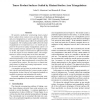Free Online Productivity Tools
i2Speak
i2Symbol
i2OCR
iTex2Img
iWeb2Print
iWeb2Shot
i2Type
iPdf2Split
iPdf2Merge
i2Bopomofo
i2Arabic
i2Style
i2Image
i2PDF
iLatex2Rtf
Sci2ools
VISUALIZATION
1995
IEEE
1995
IEEE
Tensor Product Surfaces Guided by Minimal Surface Area Triangulations
We present a method for constructing tensor product Bezier surfaces from contour (cross-section) data. Minimal area triangulations are used to guide the surface construction, and the final surface reflects the optimality of the triangulation. The resulting surface differs from the initial triangulation in two important ways: it is smooth (as opposed to the piecewise planar triangulation), and it is in tensor product form (as opposed to the irregular triangular mesh). The surface reconstruction is efficient because we do not require an exact minimal surface. The triangulations are used as strong hints, but no more than that. The method requires the computation of both open and closed isoparametric curves of the surface, using triangulations as a guide. These isoparametric curves form a tensor product Bezier surface. We show how to control sampling density by filling and pruning isoparametric curves, for accuracy and economy. A rectangular grid of points is produced that is compatib...
Isoparametric Curves | Product Bezier Surface | Tensor Product | Visualization | VISUALIZATION 1995 |
| Added | 26 Aug 2010 |
| Updated | 26 Aug 2010 |
| Type | Conference |
| Year | 1995 |
| Where | VISUALIZATION |
| Authors | John K. Johnstone, Kenneth R. Sloan |
Comments (0)

